Zoukei Mura 1/32 A-1H Skyraider
|
KIT #: |
? |
|
PRICE: |
$215.00 |
|
DECALS: |
Two options |
|
REVIEWER: |
Tom
Cleaver |
|
NOTES: |
|
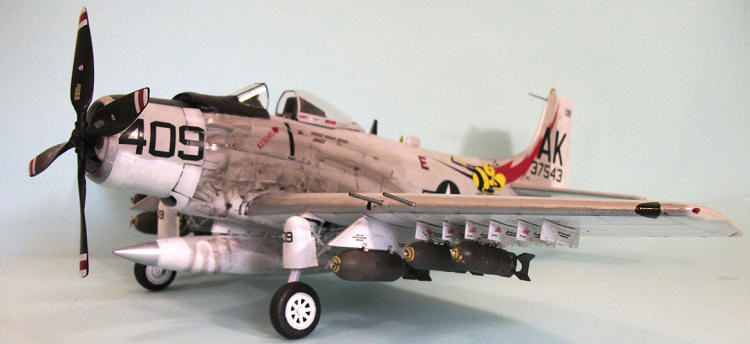
The Skyraider began life as a 1944 Navy proposal for an
airplane to replace the SB2C Helldiver and TBF Avenger, a single-seat aircraft
equally capable as a dive or torpedo bomber.
Designed by the legendary Ed Heineman at
Douglas,
the prototype was ordered as the XBT2D-1 on
July 6, 1944,
with its first flight on March 18,
1945.
The airplane was “right” and passed manufacturer’s tests
by the following April, at which time the Navy began testing it over the next
year.
Redesignated AD-1 (Attack,
Douglas),
it was ordered into production in April 1945 as the BT2D-1, with 548 aircraft
ordered.
This was reduced to 277 in September 1945.
In 1946 the aircraft was redesignated the AD-1.
VA-1B took the first AD-1s aboard USS Midway in November
1947.
Named the Skyraider, it was the first attack aircraft capable of lifting
its own weight in ordnance.
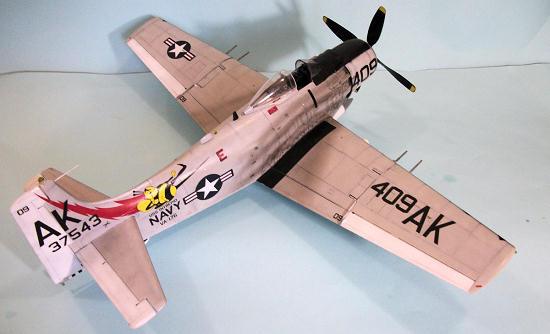 The Korean War saved the Skyraider, which was set to go
out of production in 1950 following completion of the order for AD-3s. However,
the A2D Skyshark was delayed, and there was no other aircraft capable of taking
the Skyraider’s role aboard ship.
The AD-4 increased armament from two to four 20mm cannon
in the wings.
The night attack version which first appeared as the AD-1N had
two radar operators in the rear fuselage; each subsequent sub-type included the
night attack version and others were modified for electronic countermeasures as
well as airborne early warning aircraft with a large radome under the fuselage.
The Skyraider first saw combat immediately following the
outbreak of the Korean War, and provided the heavy attack squadron for Navy
carriers throughout the conflict.
One notable attack was breaching the Hwachon Dam in
1952.
Conventional bombing would be unable to breach the dam, so the mission
was flown with torpedoes, the first (and last) use of aerial torpedoes in combat
by the Navy since the Second World War.
RADM John W. Hoskins, commanding Task Force 77 stated “I
am convinced the Skyraider is the most effective close-support aircraft in the
world!”
The Korean War saved the Skyraider, which was set to go
out of production in 1950 following completion of the order for AD-3s. However,
the A2D Skyshark was delayed, and there was no other aircraft capable of taking
the Skyraider’s role aboard ship.
The AD-4 increased armament from two to four 20mm cannon
in the wings.
The night attack version which first appeared as the AD-1N had
two radar operators in the rear fuselage; each subsequent sub-type included the
night attack version and others were modified for electronic countermeasures as
well as airborne early warning aircraft with a large radome under the fuselage.
The Skyraider first saw combat immediately following the
outbreak of the Korean War, and provided the heavy attack squadron for Navy
carriers throughout the conflict.
One notable attack was breaching the Hwachon Dam in
1952.
Conventional bombing would be unable to breach the dam, so the mission
was flown with torpedoes, the first (and last) use of aerial torpedoes in combat
by the Navy since the Second World War.
RADM John W. Hoskins, commanding Task Force 77 stated “I
am convinced the Skyraider is the most effective close-support aircraft in the
world!”
Production continued through the 1950s, as no other
design was able to replace the piston-engined Skyraider in terms of capability
and dependability.
The final version, the AD-6, appeared in 1953, produced
in parallel with the multi-seat AD-5.
Production terminated in 1956 after 713 AD-6s came off
the line.
The
AD-7 entered production shortly thereafter and the last
Skyraider built came off the production line on
February 18, 1957,
by which time 3,180 Skyraiders had been produced.
The aircraft was redesignated the A-1E/H/J when the
system was changed in 1962. It fulfilled every task from close air support to
low-level nuclear strike, night attack, airborne early warning and electronic
countermeasures, anti-submarine warfare, troop-carrying and target towing, and
even air combat against jet-powered opponents.
No other basic airframe has ever fulfilled such a
multitude of roles in Navy service, and the last Skyraiders to see combat were
operated in 1984.
In 1962, Skyraiders were transferred to the
Viet Nam
Air Force of
South Vietnam
to replace aging F8F-1B Bearcats, and the Skyraider entered its second war.
With range, load-carrying capability and loiter time,
the airplane was an unbeatable combination and was so good at what it did that
the Air Force decided in 1964 to begin operating the airplane.
Navy attack squadrons entered direct combat in the
spring of 1964, flying air support missions over
Laos.
The aircraft took part in the attacks on
North Vietnam
following the alleged
Tonkin
Gulf
“incident” (which never happened as official proclamations declared) in August
1964.
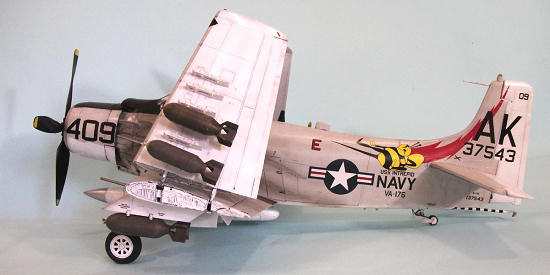 The Air Force used the airplane for air support in
South Vietnam,
and to provide close air support for rescue operation in
North Vietnam
to pick up downed fliers.
It was also used in night attacks on the Ho Chi Minh
Trail in
North Vietnam,
Laos
and
South Vietnam.
While the Navy finally phased the airplane out in 1968,
the Air Force continued using Skyraiders until the end of American participation
in the war in 1972.
The South Vietnamese air force used the airplane up to
the fall of
South Vietnam
in 1975.
The Air Force used the airplane for air support in
South Vietnam,
and to provide close air support for rescue operation in
North Vietnam
to pick up downed fliers.
It was also used in night attacks on the Ho Chi Minh
Trail in
North Vietnam,
Laos
and
South Vietnam.
While the Navy finally phased the airplane out in 1968,
the Air Force continued using Skyraiders until the end of American participation
in the war in 1972.
The South Vietnamese air force used the airplane up to
the fall of
South Vietnam
in 1975.
The French Air Force took delivery of AD-4N Skyraiders
in 1958 under the Military Assistance Program to replace the aging F4U-7
Corsairs.
These were used on operations in
Algeria
up until independence was declared in 1962.
The French operated their Skyraiders in numerous small
African wars for the next twenty years, with the final combat coming in the
Chad
civil war in the mid-1980s; this was the last operational use of the Skyraider
by any air force.
The AEW version of the Skyraider was also used by the
British Fleet Air Arm from 1955-64, during which the airplane saw combat during
the
Suez
Intervention in 1956, and was also used at the end of its career to spot
Indonesian ships and aircraft during the confrontation with
Indonesia
in 1962-64.
Today there are several Skyraider warbirds in operation
in both the
United States
and
Europe.
These are almost entirely ex-French Skyraiders, since
they were the ones used most recently with the greatest availability of spare
parts.
At least two AD-5/A-1E multi-seat Skyraiders are still flown.
The A-1E flown by Major Bernie Fisher on his Medal of
Honor mission in 1965 is on display at the
Air
Force
Museum
at Wright-Patterson AFB in
Ohio.
Skyraiders appeared in the motion pictures “The Bridges
At Toko-Ri,” “Flight of the Intruder” and “Rescue Dawn.”
Skyraider
vs. MiG-17:
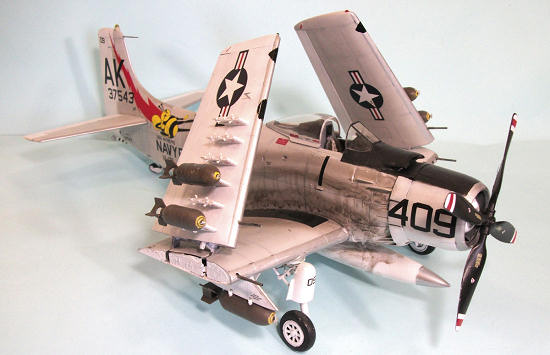 Surprisingly, the Skyraider was the victor in two air
combats against MiG-17 jet fighters over
North Vietnam.
The first happened on June 20, 1965, when two Skyraiders
of VA-25 operating off the USS Midway
flown by Lieutenant Clinton B. Johnson and Lieutenant(j.g.) Charles W. Hartman
III
were jumped while on a low-level rescue attempt in North Vietnam, with the
result that the one MiG that slowed to enter combat through the inexperience of
its pilot was shot down by the two Skyraiders.
VA-25 never let the F-4 Phantom squadron aboard the
Midway forget who had shot down a
fighter.
Surprisingly, the Skyraider was the victor in two air
combats against MiG-17 jet fighters over
North Vietnam.
The first happened on June 20, 1965, when two Skyraiders
of VA-25 operating off the USS Midway
flown by Lieutenant Clinton B. Johnson and Lieutenant(j.g.) Charles W. Hartman
III
were jumped while on a low-level rescue attempt in North Vietnam, with the
result that the one MiG that slowed to enter combat through the inexperience of
its pilot was shot down by the two Skyraiders.
VA-25 never let the F-4 Phantom squadron aboard the
Midway forget who had shot down a
fighter.
In April 1966, VA-176 went aboard the USS Intrepid (CVS-11)
to form the first all-attack carrier air wing sent to combat in
Southeast Asia,
with Intrepid carrying two Skyraider squadrons and two Skyhawk squadrons.
Once in combat, the air wing was primarily involved in
close air support operations over
South Vietnam
operating from
Dixie
Station in support of the Marines in I Corps.
That fall the ship moved north to take part in Rolling
Thunder attacks against
North Vietnam.
On
October 9, 1966,
Papoose flight was launched to provide close air cover for a RESCAP operation in
North Vietnam
south of
Hanoi
in the
Red River
Delta.
The lead section was LCDR Leo Cook and his wingman LTJG Wiley, with the
second section composed of section leader LT Peter Russell and wingman LTJG Tom
Patton.
The monsoon season was coming, and the weather conditions were composed
of low clouds and light mist over the region.
While maneuvering at low altitude between ridges and
clouds to try and spot the downed pilot, Cook and Wiley were jumped by four
North Vietnamese MiG-17s.
Calling out the attack, Cook and Wiley stayed low and
used their low-speed maneuverability to turn into the attacks as they fought for
their lives and called for help.
Russell and Patton, operating in a neighboring valley,
popped over the ridge to give support and found
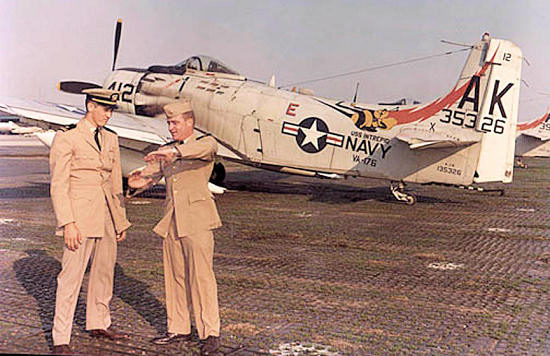 themselves
directly behind two of the North Vietnamese jets.
Patton, flying A-1H BuNo 137543 under the callsign
“Papoose-409," was closest to the enemy fighters and opened fire with his four
20mm cannon from the MiG’s six o-clock.
The jet caught fire and went in from low altitude.
Russell fired at the second MiG and claimed the
airplane, while Cook and Wiley put in a claim for a third.
The final credit was one MiG-17 destroyed by Patton, one
probably destroyed by Russell, and one damaged by Cook and Wiley.
themselves
directly behind two of the North Vietnamese jets.
Patton, flying A-1H BuNo 137543 under the callsign
“Papoose-409," was closest to the enemy fighters and opened fire with his four
20mm cannon from the MiG’s six o-clock.
The jet caught fire and went in from low altitude.
Russell fired at the second MiG and claimed the
airplane, while Cook and Wiley put in a claim for a third.
The final credit was one MiG-17 destroyed by Patton, one
probably destroyed by Russell, and one damaged by Cook and Wiley.
VA-176 returned to the east coast on completion of this
Southeast Asia
deployment and went aboard the USS
Saratoga
that Spring. On
June 8, 1967,
the squadron’s aircraft were prepared for launch to bomb Israeli air bases
following the unprovoked Israeli attack on and sinking of the USS
Liberty off the coast of
Egypt
on the third day of the Six-Day War, but the mission was called off before
launch.
Following return to the
United States
that fall, VA-176 transitioned to the A-6 Intruder.
Zoukei-Mura’s 1/32 A-1H/J Skyraider is this company’s
third release after a 1/32 Shinden and 1/32 Ta-152H; it is the only
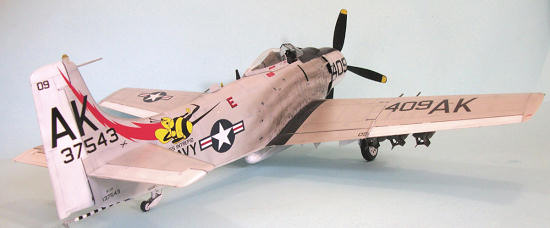 1/32
Skyraider kit released so far, though Trumpeter has announced a series of AD-4,
A-1E and A-1H Skyraiders, though with no announced release date.
1/32
Skyraider kit released so far, though Trumpeter has announced a series of AD-4,
A-1E and A-1H Skyraiders, though with no announced release date.
The kit follows Zoukei-Mura’s policy of providing the
most interior detail in their kits of any company.
The R-3350 engine is completely detailed and is the
proverbial “model on its own.”
The wingfold can be made to operate.
As is usual with Z-M kits, there is a great deal of
interior detail a modeler can add that will never be seen once the model is
completed.
Decals are provided for Tom Patton’s MiG-killer, “Papoose-409,”
as well as the aircraft flown on that mission by his element leader LT Russell,
“Papoose-405.”
Some modelers have complained that VA-176 has been “done to
death” by companies, but the fact is their famous bumblebee and thunderbolt tail
insignia is without a doubt the most dramatic markings ever carried by a
Skyraider.
No underwing ordnance is provided, but a separate kit of bombs
and rockets is available.
It is interesting to note that the kit includes a
nicely-done Yankee extraction seat and a larger tailwheel as was used for
operation from land bases.
With these parts, a modeler can easily do an Air Force “Sandy.”
Zotz Decals has released two aftermarket sheets for this
kit, one of Navy Skyraiders and one of Air Force Skyraiders including the
colorful “Lieutenant
America.”
It is very important when starting one of these kits by
Zoukei-Mura that one familiarize themself with the instruction booklet and the
instruction sequence.
There are a lot of sub-assemblies here, and it is
important that they be assembled correctly; with the large number of parts in
the very big box, it is easy to forget something or misplace it if you are not
carefully paying attention to what you are doing.
 This particular model was being built for display at the
Planes of
Fame
Air
Museum,
so I knew that I wanted to have the wingfold option operational.
I also thought of displaying the cowling open to reveal
the engine, but was defeated in the end by an inability to suss out how to
successfully attach the very complicated exhaust system; thus the engine is
enclosed in the cowling.
I had contemplated using aftermarket decals, but Ed
Maloney told me he liked the “airshow paint job” of Papoose-409 (there’s a
reason why three of the five flying Skyraiders in the country carry that
marking).
This particular model was being built for display at the
Planes of
Fame
Air
Museum,
so I knew that I wanted to have the wingfold option operational.
I also thought of displaying the cowling open to reveal
the engine, but was defeated in the end by an inability to suss out how to
successfully attach the very complicated exhaust system; thus the engine is
enclosed in the cowling.
I had contemplated using aftermarket decals, but Ed
Maloney told me he liked the “airshow paint job” of Papoose-409 (there’s a
reason why three of the five flying Skyraiders in the country carry that
marking).
I had wondered if all the interior structure would be
necessary.
I found as I went along that the additional strength of these
parts was necessary given the size of the exterior airframe parts.
I was puzzled by the breakdown of the fuselage, but it
leads me to think that there might also be an A-1E in the company’s future
plans.
I had already decided I wasn’t going to make the dive
brakes operational, since they are almost always closed when a Skyraider is
parked.
Ditto the flaps, which are always raised after landing.
I began by gluing the fore and aft parts of the fuselage
halves together, being sure to give the joint as much strength as possible from
inside. If you are careful there is no seam filling to do here, since the break
is along a panel line.
The same is true for the upper and lower parts of the
fuselage as construction continues.
I painted the cockpit and detailed it, using the kit
decal for the instrument panel, then assembled and attached the cockpit and the
interior bulkheads.
I did not add the various pieces of internal equipment,
since they will never be seen.
I then assembled the fuselage and glued the dive brakes
in the closed position, then attached the engine mount and finally the lower
forward panels of the fuselage.
When this was done I set the entire sub-assembly aside.
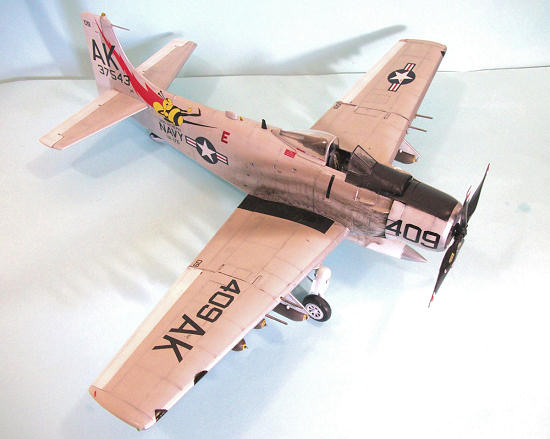 The wings were next.
I first glued the gun bay covers in position from inside
(if you’re going to open the gun bays there is a lot of extra detailing that
will be necessary, such as the addition of wiring and such, to get a realistic
look), then assembled the wings per instructions, attaching the lower wing
center section to the fuselage before gluing the upper halves on after
assembling the internal structure.
The parts breakdown and assembly sequence for the wings
are very straightforward, and I had no problem getting the wing fold to work.
The wing assembly was glued to the lower center section
and the fuselage, and the horizontal stabilizers were attached.
I then attached the control surfaces all in the neutral
position they would be in when the airplane is parked.
The wings were next.
I first glued the gun bay covers in position from inside
(if you’re going to open the gun bays there is a lot of extra detailing that
will be necessary, such as the addition of wiring and such, to get a realistic
look), then assembled the wings per instructions, attaching the lower wing
center section to the fuselage before gluing the upper halves on after
assembling the internal structure.
The parts breakdown and assembly sequence for the wings
are very straightforward, and I had no problem getting the wing fold to work.
The wing assembly was glued to the lower center section
and the fuselage, and the horizontal stabilizers were attached.
I then attached the control surfaces all in the neutral
position they would be in when the airplane is parked.
The engine is indeed a “kit on its own” and fully
deserving of being seen.
Assembly of the very complicated exhaust system is not
fully shown in the instructions, and I ended frustrated that parts were not
fitting as they should.
At that point I decided to attach the cooling flaps and
close them, and close up the cowling around the engine.
This made things much easier.
The model was painted with Xtracrylix “Light Gull Grey”
and “White,” after being pre-shaded with flat black along all the panel lines.
The coroguard on the leading edges of the wings and tail
surfaces were painted with Tamiya Aluminum and then masked off before further
finish painting.
I finished off with a coat of Xtracrylix Gloss varnish.
The kit decals went on without problem, but I made sure
to have lots of water on the surface as I slid the large bumblebee insignia onto
the tail.
I let that fully set up before proceeding with any more decals.
All the decals worked well when soaked to the point they
were ready to float off the backing paper, and went down without problems under
a coat of Solvaset (since they are a bit thick).
I gave the model an overall coat of Xtracrylix Satin,
then gave the upper surfaces a coat of Xtracrylix Flat.
The Skyraider is a “dirty bird.”
If you get the exhaust stains and oil stains right, it
looks like nothing
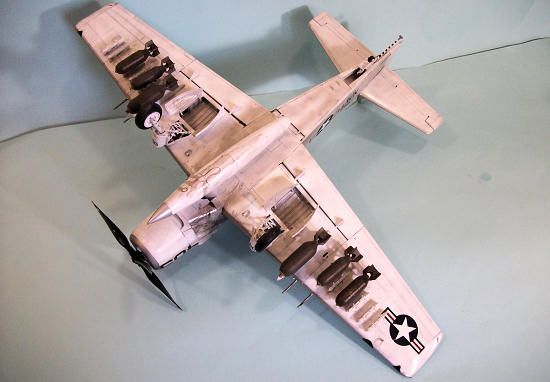 a
pilot would climb into.
Using the in-flight photo of a VA-176 airplane I am
providing here, I applied Tamiya “Smoke” over the fuselage and inner wing and
lower fuselage.
I then applied several brushfuls of thinned “Smoke” and let them
drip down to get the really stained look of most operational Skyraiders.
I also applied thinned “Smoke” in the wheel wells, the
interiors of the gear doors and on the landing gear to get that “used” look.
a
pilot would climb into.
Using the in-flight photo of a VA-176 airplane I am
providing here, I applied Tamiya “Smoke” over the fuselage and inner wing and
lower fuselage.
I then applied several brushfuls of thinned “Smoke” and let them
drip down to get the really stained look of most operational Skyraiders.
I also applied thinned “Smoke” in the wheel wells, the
interiors of the gear doors and on the landing gear to get that “used” look.
VA-176 operated in
Southeast Asia
during the “bomb shortage.”
With the lack of available ordnance, the propeller
attack aircraft were armed with World War II-era “fat” bombs so the
“streamlined” bombs could be saved for jet aircraft.
Rather than get the ordnance kit from Z-M, I raided the
spares box and got bombs left over from Trumpeter P-47 kits.
Be aware that the Aero-14 racks on the outer wings can
carry a maximum 500 pounds each.
I used four 500-lb bombs, and two 750-lb bombs that I
mounted on the inner pylons.
All the photos I have found of VA-176 Skyraiders (there
are a lot at the squadron’s official website) show they operated primarily with
the single centerline tank, keeping the wing stations open for ordnance.
I attached the landing gear and doors, then the prop. I
unmasked the canopy and posed it in the open position.
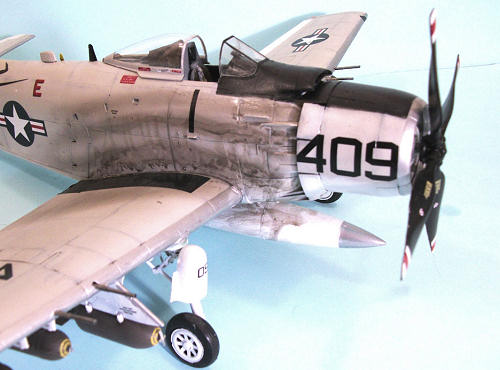 I have not been impressed with Zoukei-Mura’s previous
efforts.
I didn’t want to do the Shinden after seeing it in the box, and friends
who have done it report lots of fit problems.
I was so unimpressed with the Ta-152 that it sits
half-completed on the Shelf of Doom, likely never to see the light of day (I
personally think the PCM kit is far superior, since it can be built without
using an entire tube of Green Stuff to hide the poor fit of this badly-designed
kit).
I have not been impressed with Zoukei-Mura’s previous
efforts.
I didn’t want to do the Shinden after seeing it in the box, and friends
who have done it report lots of fit problems.
I was so unimpressed with the Ta-152 that it sits
half-completed on the Shelf of Doom, likely never to see the light of day (I
personally think the PCM kit is far superior, since it can be built without
using an entire tube of Green Stuff to hide the poor fit of this badly-designed
kit).
That said, I like this Skyraider.
I only had about 10 percent of the parts left over after
assembling it without worrying about what wouldn’t be seen in the end.
The kit is complex but not complicated in assembly
(other than that ferschlugginah exhaust system), and the end result is a very
impressive, big (nearly 3/4 the size of the H-K B-25J!) model.
A modeler who wanted to take their time on the detailing
of this kit could end up with a show-stopper.
If they release an A-1E, I’ll be interested in doing it.
Recommended for experience modelers with a good
attention span and patience.
Yes, it’s expensive,
but you definitely get what you pay for with this model.
It’s not produced in huge numbers.
February 2012
Tom Cleaver
Review Kit courtesy
of Cooper’s Models.
Order yours at:
www.coopersmodels.com
If you would like your product reviewed fairly and fairly quickly, please contact the editor or see other details in the
Note to
Contributors.
Back to the Main Page
Back to the Review
Index Page



 The Air Force used the airplane for air support in
The Air Force used the airplane for air support in

 themselves
directly behind two of the North Vietnamese jets.
Patton, flying A-1H BuNo 137543 under the callsign
“Papoose-409," was closest to the enemy fighters and opened fire with his four
20mm cannon from the MiG’s six o-clock.
The jet caught fire and went in from low altitude.
Russell fired at the second MiG and claimed the
airplane, while Cook and Wiley put in a claim for a third.
The final credit was one MiG-17 destroyed by Patton, one
probably destroyed by Russell, and one damaged by Cook and Wiley.
themselves
directly behind two of the North Vietnamese jets.
Patton, flying A-1H BuNo 137543 under the callsign
“Papoose-409," was closest to the enemy fighters and opened fire with his four
20mm cannon from the MiG’s six o-clock.
The jet caught fire and went in from low altitude.
Russell fired at the second MiG and claimed the
airplane, while Cook and Wiley put in a claim for a third.
The final credit was one MiG-17 destroyed by Patton, one
probably destroyed by Russell, and one damaged by Cook and Wiley. 1/32
Skyraider kit released so far, though Trumpeter has announced a series of AD-4,
A-1E and A-1H Skyraiders, though with no announced release date.
1/32
Skyraider kit released so far, though Trumpeter has announced a series of AD-4,
A-1E and A-1H Skyraiders, though with no announced release date.


